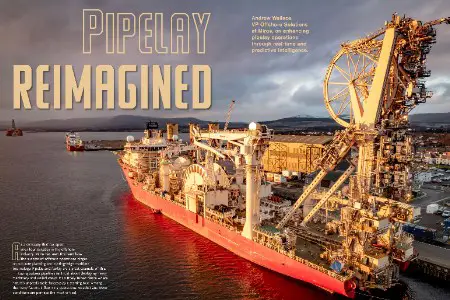Andrew Wallace,
VP Offshore Solutions at Miros, on enhancing pipelay operations through real-time and predictive intelligence.

As a company that has spent over four decades in the offshore industry, Miros has seen firsthand how the success of offshore operations hinges on accurate planning and cutting-edge maritime technology. Pipelay and flexlay are a great example of this.
Laying subsea pipelines isn’t just about deploying heavy machinery and skilled crews; it’s a finely tuned dance where nature’s unpredictable forces play a starring role. Among the many factors influencing operations, weather and wave conditions are perhaps the most critical.
For instance, a sudden rise in wave height can cause vessel instability, increasing stress on product and equipment and risking damage to the subsea infrastructure. This makes precise in-operation monitoring and forecasting essential to maintaining operational safety and efficiency. That’s where the integration of operation-critical, real-time measurements and predictive insights has transformed how our clients approach these challenges. In addition, leveraging cutting-edge technologies like AI-powered wave and vessel motion prediction can be a game-changer for maritime safety and operational efficiency.
Understanding the impact of sea state on pipelay and flexlay operations
Pipelay and flexlay operations involve deploying rigid or flexible pipelines on the seabed, often in challenging environments where water depths, currents, and seabed conditions vary significantly. The method we use depends largely on the project’s requirements:
- S-lay: the pipe forms an ‘S’ shape from the vessel to the seabed, typically used in shallow to moderate depths.
- J-lay: the pipe descends almost vertically, suitable for deepwater applications.
- Reel-lay: pipes are prefabricated and spooled onto large reels, enabling rapid deployment for shorter pipelines.
- Flexlay: similar to reel-lay but focused on deploying flexible pipes for dynamic applications.
Regardless of the method, each operation is highly sensitive to environmental conditions, particularly waves. For instance, high wave heights can increase the stress on the stinger and the pipeline, while long wave periods can amplify vessel motion, making precise pipe deployment more challenging. In J-lay operations, excessive vessel movement can compromise the vertical alignment required for deep-water installations, whereas in S-lay, lateral wave forces can disrupt the pipe’s smooth descent to the seabed. A slight miscalculation can jeopardise the pipeline’s integrity, damage equipment, or put the crew at risk. This is why having accurate weather forecasts and real-time wave measurements is non-negotiable.
The role of weather forecasts in offshore operations
Before any pipelay operation begins, our clients spend weeks, sometimes months, analysing weather forecasts to identify the safest and most efficient operational windows. Waves, wind, and currents directly impact vessel stability, pipeline tension, and the precision required for subsea deployment. High seas can cause the vessel to pitch and roll, increasing stress on the pipeline and the stinger, a curved structure guiding the pipe to the seabed.
For our customers and, by extension, Miros, one of the most critical lessons has been to thoroughly understand the interplay between forecasted and real-time data. While long-term forecasts give us a broad operational timeline, they lack the granularity needed for day-to-day decision-making. A forecast might predict calm seas for the week, but real-time data could reveal a sudden change in conditions, requiring immediate adjustments by the minute or even second. This is where the Miros WaveSystem has been invaluable. Committed to aligning with our customers’ needs we work closely together with our users to ensure the solutions deliver measurable value and continuously evolve to meet operational demands.
Driving efficiency in pipelay operations
The WaveSystem provides high-accuracy, real-time wave and sea-state data. Unlike traditional wave buoys, which can be limited by deployment constraints and maintenance challenges, the Miros system uses radar technology to deliver immediate and precise measurements directly from the vessel. This eliminates delays in data availability and enhances operational responsiveness, making it a clear upgrade over conventional methods. Wave buoys can be cumbersome to position and uphold, whereas the WaveSystem is dry-mounted and uses radar technology to measure wave height, period, and direction directly from the vessel, all delivered through secure and reliable cyber services. The benefits of this are profound:
- Immediate insights: having real-time wave data to hand allows for up-to-the-second monitoring of sea conditions as they evolve, ensuring instant and accurate decisions to adapt operations.
- Improved safety: by continuously tracking wave heights and directions, conditions that might compromise vessel stability or pipeline integrity can be avoided.
- Operational efficiency: real-time measurements help optimise tensioner settings and stinger angles, ensuring the pipeline is laid smoothly and safely.
For instance, during a recent project in the North Sea, the crew detected an unexpected secondary wave system that wasn’t reflected in the initial weather forecast. Because they could measure this occurrence in real-time, our client was able to adjust the vessel’s positioning and delay certain high-risk tasks until conditions stabilised. This proactive approach prevented potential equipment damage and safeguarded the integrity of the project.
To access the full version of this article and get a free trial subscription to World Pipelines, sign up here!
Read the article online at: https://www.worldpipelines.com/special-reports/10042025/pipelay-reimagined/

